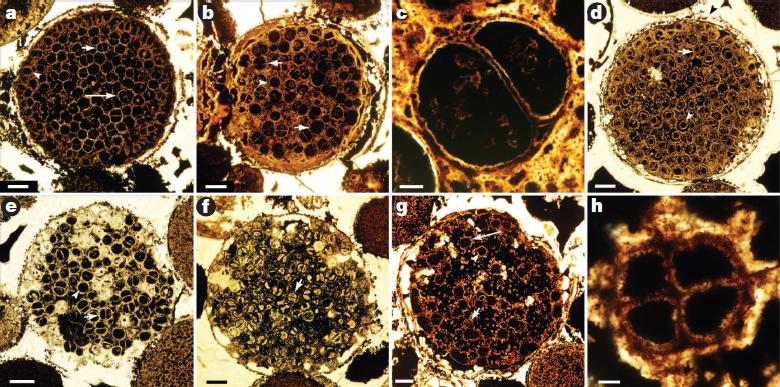The Ediacaran Doushantuo Formation at Weng’an in South China provides a valuable taphonomic window into the early evolution of complex multicellular eukaryotes, including possible animals. Among the most controversial and potentially most important Doushantuo fossils is the spheroidal fossil Megasphaera, which has blastula-like cells enclosed in a thick ornamented envelope and exhibiting palintomic cell cleavages. Megasphaera was interpreted as animal embryos by Professor Shuhai Xiao and colleagues in an article published in Nature in 1998, but other researchers have proposed that Megasphaera might be a volvocine alga, a mesomycetozoean-like holozoan, a unicellular protist, or a bacterium. However, the life cycle of Megasphaera is poorly understood, critically hampering scientists’ ability to differentiating these different interpretations.
In a recent paper published in Nature on Sep. 24, 2014, researchers from the Nanjing Institute of Geology and Paleontology, Chinese Academy of Science and Virginia Tech reported new fossils from black phosphorite of the Doushantuo Formation at Weng’an, a unit that was overlooked in previous investigation of animal embryo-like fossils. The new material includes specimens representing late developmental stages of Megasphaera that show clear evidence for flexible cell membrane, cell differentiation, germ-soma separation, and programmed cell death. Based on the new evidence, the researchers conclude that Megasphaera is a complex multicellular eukaryote, most likely belonging to stem-group animals or algae. More investigation is needed to fully document the life cycle and to further determine the phylogenetic affinity of Megasphaera.
The Nature paper was co-authored by CHEN Lei, Shuhai Xiao, PANG Ke, ZHOU Chuanming, and YUAN Xunlai. The research was supported by National Natural Science Foundation of China, US National Science Foundation, Chinese Academy of Sciences, and Chinese Ministry of Science and Technoogy.
Related information of the paper: Lei Chen, Shuhai Xiao, Ke Pang, Chuanming Zhou, Xunlai Yuan. Cell differentiation and germ–soma separation in Ediacaran animal embryo-like fossils. Nature, 2014; DOI: 10.1038/nature13766

Figure 1| Early developmental stages of Megasphaera.a, One-cell stage. b,Parapandorina-stage. c–h, Megaclonophycus stage.

Figure 2| Megaclonophycus-like fossils with dividing cell packets. Showa few cells begin totaken differentiation.

Figure 3| Megaclonophycus-like fossils with one or more spheroidal to ellipsoidal multicellular structures.Show clear evidence for cell differentiation—cells specialised for reproduction continually dividing, forming matryoshkas-like growing structures.
